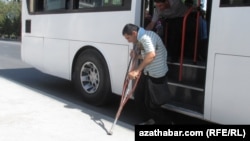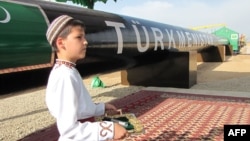After almost a decade of absence, U.S. diplomacy is back in the Caspian energy game. This is happening as the toughest nut that prevented Central Asian gas from reaching European markets is just in the process of being cracked. That is the Trans-Caspian Gas Pipeline (TCGP) and its transmission systems to Europe, including the White Stream pipeline under the Black Sea.
It is happening just as the Trump administration's new National Security Strategy asserts that the United States "pursues economic ties not only for market access but also to create enduring relationships to advance common political and security interests." It contrasts this with Russia's perceived projection of influence "through the control of key energy and other infrastructure throughout parts of Europe and Central Asia."
The Trans-Caspian Gas Pipeline: A Long Time Coming
In the mid-1990s, the two U.S. companies Bechtel and the GE Capital unit of General Electric formed PSG, a joint venture that contracted in 1998 to construct the TCGP (also called TCP) from Turkmenistan to Azerbaijan. Despite the fact that the project's economics were robust and its planning was well advanced, other factors nevertheless contributed to derailing it.
Partners in the Nabucco pipeline project tried, about a decade ago, to get 10 billion cubic meters per year (bcm/y) of gas from Turkmenistan to improve their own economic chances. However, Russia and Iran used excuses about environmental security (which have well established technical solutions) to block it politically. They also contended that all five Caspian Sea littoral countries should have to approve any pipeline, although this contention never prevented Kazakhstan and Russia from cooperating on their own bilateral offshore joint ventures.
All this changed late last year. In December 2017, Russian Foreign Minister Sergei Lavrov announced that agreement had been reached among the five littoral states over the text of a convention to establish an international legal regime for the Caspian Sea. Azerbaijani Deputy Foreign Minister Khalaf Khalafov specifically clarified that "rights for laying pipelines are foreseen in the draft convention" and that "those countries through whose sectors [the pipelines] will run" are the ones that "will coordinate the issue."
Why The EU Wants And Needs The TCGP
European imports of Russian natural gas are forecast to rise from the present level of slightly over 30 percent of all natural-gas imports to 35 percent by 2025 and 40 percent by the 2030s. The European Union officially sees the TCGP as a complementary element of the Southern Gas Corridor.
Permitting the construction of the TCGP is established as a matter for the participating countries, Turkmenistan and Azerbaijan, alone. With this, the final excuse to block construction of the TCGP disappears. Late last summer, at a bilateral summit in Ashgabat, the two countries for the first time signed a memorandum endorsing that principle and declaring their intent to cooperate not only in energy transmission but also in transportation and a host of other matters.
The European Union has put the TCGP on its List Of Projects Of Common Interest, making it eligible for preferential consideration for support from EU funding agencies and European banks. Should events continue progressing quickly, gas from the TCGP's first string may arrive in Italy for European distribution already in 2020, and from the second string in Romania in 2022. The responsible Georgian ministry has presented such a vision and road map to the Energy Community (download PowerPoint here).
Yet Turkmenistan will have little appetite to export gas through the TCGP's first string unless it has confidence that the second string will also be built; and the TCGP's second string requires the White Stream's construction for the gas from the second string to reach Europe.
Two Entry Points For Turkmen Gas To Europe
The route for the first string is already well established and well under construction: through Azerbaijan and the South Caucasus Pipeline (SCP, already undergoing expansion to become SCPx), then through Turkey and the Trans-Anatolian Gas Pipeline (TANAP), and finally across Greece and to Italy via the Trans-Adriatic Pipeline (TAP). Although the system starting with SCPx, including its further expansion SCPF(x), and continuing through the TANAP-TAP connection, would take gas from the TCGP's first string, nevertheless it would not be sufficient to handle quantities via the second string as well.
Turkmenistan underlines its ability, in line with its objectives, to export 30-40 bcm/y, which is the capacity of the East-West Pipeline that it has constructed domestically for this purpose. The country has always sought an arrangement for larger volumes, allowing higher overall revenues. Clarity about prospects for the second string thus seems necessary before gas may be committed for the first string.
The second route from Turkmenistan to Europe literally has one missing link (also the key link). It is the White Stream pipeline, from Georgia to Romania under the Black Sea, for the TCGP's second string. Coming via Azerbaijan and Georgia, Turkmenistan's natural gas would be taken under the Black Sea by the White Stream pipeline to Romania. It would use the ultra-deep-sea technology that has become much more economical and widely available since first developed by Russia for the Blue Stream to Turkey, now being used also for the Turkish Stream pipeline.
From Romania, already landed in European Union territory, Turkmenistan's gas would transit to Central Europe: both through the BRUA (Bulgaria-Romania-Hungary-Austria, "U" for Ungaria) pipeline now under construction; and also via the Trans-Balkan Pipeline then through Ukraine (after Gazprom's contract for Romania's and Ukraine's gas transport systems runs out in a few years) to Poland and, via the Bratstvo pipeline, to Slovakia whence Germany via the Czech Republic, as well as Austria.
Making The Southern Gas Corridor Really Strategic
The new U.S. National Security Strategy addresses such a situation by affirming that Washington will "help our allies and partners become more resilient against those that use energy to coerce" and "support the diversification of energy sources, supplies, and routes at home and abroad." It provides a firm basis for diplomatic support for the TCGP initiative, including White Stream. Following the strategic line defined in the new National Security Strategy, the United States could draw significant benefit here for a relatively small investment of support in this initiative.
Indeed, it was in the context of such diversification that acting Special Envoy and Coordinator for International Energy Affairs at the U.S. Department of State Sue Saarnio affirmed toward the end of last year that the Southern Gas Corridor (SGC) "could be expanded to deliver additional volumes from...Turkmenistan," thus becoming "a basis for positive cooperation across the region...while helping to underpin Europe's long-term energy security."
Gas from Turkmenistan would also enhance competition, affecting prices, and so making the SGC a genuinely strategic project for Europe as well. However, the window of opportunity for Turkmen gas may be a narrow one, as the European energy market is undergoing transformation. When large investments are made elsewhere, it may become difficult to add this further new infrastructure.
The views expressed by the author do not necessarily reflect those of RFE/RL. Robert M. Cutler is senior researcher, Center of European, Russian and Eurasian Studies, Carleton University; and fellow, Canadian Energy Research Institute







